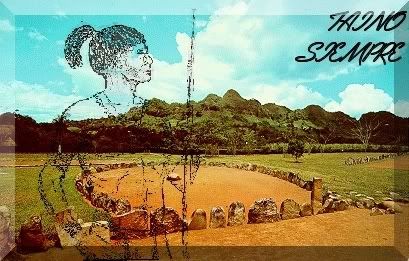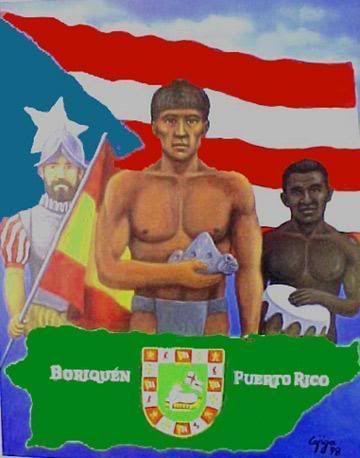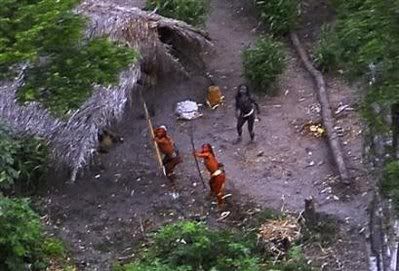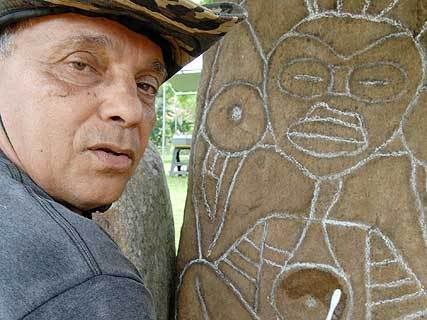Monday, June 16, 2008
Sunday, June 15, 2008
Happy Fathers Day Taino Style
Happy Fathers Day Taino Style

Our Father" in Taíno:
Guakia baba (Our Father)
turey toca (is in sky)
guami-ke-ni (Lord of land and water)
guami-caraya-guey (Lord of moon and sun)
guariko (come to)
guakia (us)
tayno-ti (good,tall)
bo-matun; (big,generous)
busica (give to )
guakia (us)
aje-cazabi; (tubercles,bread)
juracan-na (bad spirit,no)
maboya-ua (ghost,no)
jukiyu-jan; (good spirit,yes)
Diosa (of God)
nabori daca ( servant am I)
Jan-jan catu (So be it)
[from Prehistoria de Puerto Rico, Dr.
Cayetano Coll y Toste]

Our Father" in Taíno:
Guakia baba (Our Father)
turey toca (is in sky)
guami-ke-ni (Lord of land and water)
guami-caraya-guey (Lord of moon and sun)
guariko (come to)
guakia (us)
tayno-ti (good,tall)
bo-matun; (big,generous)
busica (give to )
guakia (us)
aje-cazabi; (tubercles,bread)
juracan-na (bad spirit,no)
maboya-ua (ghost,no)
jukiyu-jan; (good spirit,yes)
Diosa (of God)
nabori daca ( servant am I)
Jan-jan catu (So be it)
[from Prehistoria de Puerto Rico, Dr.
Cayetano Coll y Toste]
Thursday, June 5, 2008
A Simple Message: Leave the Puerto Rican Flag Alone
A Simple Message: Leave the Puerto Rican Flag Alone
----------------- Bulletin Message -----------------
From: taino ray
Date: Jun 5, 2008 7:53 AM

Fellow Boricuas
Its Puerto Rican Day Parade time again.. I know I shouldn't have to say this but I will anyway, I must.
Wave your flag with pride this weekend
Mount it on a flagpole, present it with dignity
Show the world our BORICUA PRIDE
Remember always where you come from & pass it on to your children
Be Boricua always ( don't forget after the parade is over)
NOVEMBER is Puerto Rican Heritage Month ( you can look it up)
Please don't desecrate our flag.
Don't drape on the hood of your car because it gets dirty from your cars emissions.
( a dirty, oily flag is not cool)
Men stop wearing it as skirts or capes, (Keep it real!!!! )
Women stop wearing it as a Bra.
(keep it real!!!)
Don't buy any flags with Roosters, Coquis, Bikini Women etc
(You got to be kidding me right)
IF WE DON'T RESPECT OUR FLAG NO ONE ELSE WILL!!!!!

We honor our Taino Hands, because they worked
We honor our Spanish hands, because they worked
We honor our African hands, because they worked
All of those hands make us FAMILY
All of those hands make us
BORICUAS!!!!
A Simple Message: Leave the Flag Alone
By DAVID GONZALEZ
Published: May 31, 2005
Jaran Manzanet is not a happy man these days. That is never a good thing since he is a big man with rock-hard hands and a steely attitude, traits that served him well over four decades in the ring as both a boxer and trainer.
So who is foolish enough to darken his mood?
Skip to next paragraph
Enlarge This Image
Librado Romero/The New York Times
Jaran Manzanet has set out to stop people from embellishing the Puerto Rican flag, whether with Tito Puente or a tree frog.
Librado Romero/The New York Times
Caps with faces in front of the flag are a gray area, Mr. Manzanet says; they're not exactly flags, but are not quite respectful. Still, he must pick his battles.
Tito Puente, for starters. Plus fighting cocks, conga drums, palm trees, tree frogs and 70 other characters that by his count are emblazoned on those Puerto Rican flags that flutter everywhere as the Puerto Rican Day Parade, on June 12, approaches. All of them - even the one with the boxer Félix "Tito" Trinidad - are not some happy combination of national symbols, Mr. Manzanet said, but a desecration of the island's flag.
As his own business card declares, Mr. Manzanet is the Bronx's own Defender of the Puerto Rican Flag - a self-imposed title that he nonetheless carries like a champ. A poster taped to the side of his car urges people not to denigrate the flag. He has led protests outside garment district stores that sell all sorts of flag trinkets. He even goes as far as to hand out simple, unadorned flags to people he sees on the street who might be waving an offending banner.
"In our community there is a lot of ignorance, and we have to awaken them," he said, sitting inside a clubhouse on East 142nd Street in Mott Haven. "People from other countries tell me, they always see the Puerto Ricans with the flag. I know we're proud.
But why do we need to buy these flags with drawings on them?"
He said he had first been troubled by the misuse of the flag in the ring, when the Puerto Rican flag was turned into boxing trunks. Then came the flags people waved at parades or stuck in their windows, the ones with cartoon characters. Since then, he has amassed a collection that includes all sorts of characters, from the ubiquitous homeboy to one in which a naked woman holding two pistols stands against the flag.
Two years ago, he wrote to every mayor, representative and senator in Puerto Rico, urging them to support his campaign to uphold the honor of the flag. Only two replied. Last month, he telephoned the city's Puerto Rican politicians to try to enlist their support for a protest outside a store that sold the offensive flags. Only one sent a representative.
Nonetheless, Mr. Manzanet and a few supporters protested on April 21 outside Boricua City, a store on West 29th Street in Manhattan that is among the country's biggest suppliers of Puerto Rican flags, T-shirts, caps and jewelry. Ricky Perez, a manager at the store, told the group that the flags with cartoon characters on them were leftover inventory that would no longer be sold. Mr. Manzanet was pleased.
"He said he was going to get rid of it," Mr. Manzanet said. "As long as the flag has nothing on it, that's good.
"
Inside Boricua City - which despite its Puerto Rican name is owned by a Korean businessman - the place was jammed with boxes upon boxes of Latin American flags and caps, almost all of which are made in Taiwan or China.
Although other flags are sold at the store, Puerto Rican items are the most popular, said Kevin Young, who said he was "a backup person" at the store. He said the Puerto Rican customers were different from other Latin Americans.
"They're not picky," he said. "When they purchase, it's easy. They do not complain. It's easy to do a sale.
"
Above him, beach towels and flags covered the ceiling. One of them featured three thong-clad women facing the Puerto Rican flag, a tableau whose patriotic tenor Mr. Manzanet failed to appreciate.
"That's not a flag," Mr. Young insisted. "That's a towel.
"
There were also various caps in which Puerto Rican icons like Tito Puente appeared against a backdrop of the flag.
"Tito, the flag is behind him," Mr. Perez said. "All the protesters said was you should not put anything on the flag. We try to accommodate everybody.
"
Still, Mr. Manzanet is skeptical about the caps.
"If he wants us to stop something like that, good luck," Mr. Perez said. "It's floating. It's a 3-D illusion. Anything with 3-D is the money.
"
To some extent, Mr. Perez wondered why all the fuss over a flag that he said was not the island's true colors. He personally prefers the nationalist flag that flew over Lares, P.R., during a 19th-century rebellion against Spanish rule. He also sells that flag, which he has tucked into a place of honor in a corner of the store.
"That's our flag for real," Mr. Perez said, pointing to it. "The nationalist flag. Notice, it's first in line and there is nothing on it.
"
The fight against Spanish rule led to the current flag, which was designed in 1895 by exiles living in New York City. Some think its popularity in New York speaks to a national identity that refuses to vanish even if the island is not a sovereign state.
"The historical situation of Puerto Ricans, whether on the island or in the diaspora, is they are without a nation in terms of traditional definitions," said Arlene Davila, an associate professor of American studies at New York University. "So culture becomes a pivotal space to claim that, and cultural symbols become even more politically loaded.
"
Juan Flores, a professor of Puerto Rican studies at Hunter College, has mixed feelings about the flags.
"I'm glad this national culture is being preserved and not going away," he said. "But at the same time I always hated flag wavers. The symbol becomes more important than what Puerto Rican identity is about.
"
Making sure that identity is declared with an unadorned flag will continue to be Mr. Manzanet's mission. A few days ago, he was standing by his car when Jose Lanausse, an elevator repairman, saw the poster urging people to boycott the altered flags.
"I understand his reasoning," Mr. Lanausse said. "It takes the glory out of the flag. When I was younger, it was only the flag. Now you go to the Puerto Rican Day Parade and you see all these other things on them.
"
Mr. Manzanet asked Mr. Lanausse where he was from. New York, he said, but his parents were from Salinas, P.R . Mr. Manzanet shouted across the street to his friend Angel Alvarado, who was also from that town. Mr. Alvarado came over.
"Tell him your name and where your family is from," he said to Mr. Lanausse.
The young man complied. Within seconds, Mr. Alvarado was reeling off names.
"I know a Jorge, Franklin and Jenny Lanausse," Mr. Alvarado said. "She was a teacher and a very elegant woman. The Lanausses were known.
"
The young man seemed stunned.
"I am from the most popular neighborhood in Salinas," Mr. Alvarado explained. "Next to the cemetery. If you did not visit when you were alive, you would pass by when you were dead.
"
Ms. Manzanet beamed at how this chance encounter over a flag led to someone learning some long-lost family lore. That was why he was determined to continue his defense of the flag, vowing to go to this year's parade with friends to hand out fliers.
----------------- Bulletin Message -----------------
From: taino ray
Date: Jun 5, 2008 7:53 AM

Fellow Boricuas
Its Puerto Rican Day Parade time again.. I know I shouldn't have to say this but I will anyway, I must.
Wave your flag with pride this weekend
Mount it on a flagpole, present it with dignity
Show the world our BORICUA PRIDE
Remember always where you come from & pass it on to your children
Be Boricua always ( don't forget after the parade is over)
NOVEMBER is Puerto Rican Heritage Month ( you can look it up)
Please don't desecrate our flag.
Don't drape on the hood of your car because it gets dirty from your cars emissions.
( a dirty, oily flag is not cool)
Men stop wearing it as skirts or capes, (Keep it real!!!! )
Women stop wearing it as a Bra.
(keep it real!!!)
Don't buy any flags with Roosters, Coquis, Bikini Women etc
(You got to be kidding me right)
IF WE DON'T RESPECT OUR FLAG NO ONE ELSE WILL!!!!!

We honor our Taino Hands, because they worked
We honor our Spanish hands, because they worked
We honor our African hands, because they worked
All of those hands make us FAMILY
All of those hands make us
BORICUAS!!!!
A Simple Message: Leave the Flag Alone
By DAVID GONZALEZ
Published: May 31, 2005
Jaran Manzanet is not a happy man these days. That is never a good thing since he is a big man with rock-hard hands and a steely attitude, traits that served him well over four decades in the ring as both a boxer and trainer.
So who is foolish enough to darken his mood?
Skip to next paragraph
Enlarge This Image
Librado Romero/The New York Times
Jaran Manzanet has set out to stop people from embellishing the Puerto Rican flag, whether with Tito Puente or a tree frog.
Librado Romero/The New York Times
Caps with faces in front of the flag are a gray area, Mr. Manzanet says; they're not exactly flags, but are not quite respectful. Still, he must pick his battles.
Tito Puente, for starters. Plus fighting cocks, conga drums, palm trees, tree frogs and 70 other characters that by his count are emblazoned on those Puerto Rican flags that flutter everywhere as the Puerto Rican Day Parade, on June 12, approaches. All of them - even the one with the boxer Félix "Tito" Trinidad - are not some happy combination of national symbols, Mr. Manzanet said, but a desecration of the island's flag.
As his own business card declares, Mr. Manzanet is the Bronx's own Defender of the Puerto Rican Flag - a self-imposed title that he nonetheless carries like a champ. A poster taped to the side of his car urges people not to denigrate the flag. He has led protests outside garment district stores that sell all sorts of flag trinkets. He even goes as far as to hand out simple, unadorned flags to people he sees on the street who might be waving an offending banner.
"In our community there is a lot of ignorance, and we have to awaken them," he said, sitting inside a clubhouse on East 142nd Street in Mott Haven. "People from other countries tell me, they always see the Puerto Ricans with the flag. I know we're proud.
But why do we need to buy these flags with drawings on them?"
He said he had first been troubled by the misuse of the flag in the ring, when the Puerto Rican flag was turned into boxing trunks. Then came the flags people waved at parades or stuck in their windows, the ones with cartoon characters. Since then, he has amassed a collection that includes all sorts of characters, from the ubiquitous homeboy to one in which a naked woman holding two pistols stands against the flag.
Two years ago, he wrote to every mayor, representative and senator in Puerto Rico, urging them to support his campaign to uphold the honor of the flag. Only two replied. Last month, he telephoned the city's Puerto Rican politicians to try to enlist their support for a protest outside a store that sold the offensive flags. Only one sent a representative.
Nonetheless, Mr. Manzanet and a few supporters protested on April 21 outside Boricua City, a store on West 29th Street in Manhattan that is among the country's biggest suppliers of Puerto Rican flags, T-shirts, caps and jewelry. Ricky Perez, a manager at the store, told the group that the flags with cartoon characters on them were leftover inventory that would no longer be sold. Mr. Manzanet was pleased.
"He said he was going to get rid of it," Mr. Manzanet said. "As long as the flag has nothing on it, that's good.
"
Inside Boricua City - which despite its Puerto Rican name is owned by a Korean businessman - the place was jammed with boxes upon boxes of Latin American flags and caps, almost all of which are made in Taiwan or China.
Although other flags are sold at the store, Puerto Rican items are the most popular, said Kevin Young, who said he was "a backup person" at the store. He said the Puerto Rican customers were different from other Latin Americans.
"They're not picky," he said. "When they purchase, it's easy. They do not complain. It's easy to do a sale.
"
Above him, beach towels and flags covered the ceiling. One of them featured three thong-clad women facing the Puerto Rican flag, a tableau whose patriotic tenor Mr. Manzanet failed to appreciate.
"That's not a flag," Mr. Young insisted. "That's a towel.
"
There were also various caps in which Puerto Rican icons like Tito Puente appeared against a backdrop of the flag.
"Tito, the flag is behind him," Mr. Perez said. "All the protesters said was you should not put anything on the flag. We try to accommodate everybody.
"
Still, Mr. Manzanet is skeptical about the caps.
"If he wants us to stop something like that, good luck," Mr. Perez said. "It's floating. It's a 3-D illusion. Anything with 3-D is the money.
"
To some extent, Mr. Perez wondered why all the fuss over a flag that he said was not the island's true colors. He personally prefers the nationalist flag that flew over Lares, P.R., during a 19th-century rebellion against Spanish rule. He also sells that flag, which he has tucked into a place of honor in a corner of the store.
"That's our flag for real," Mr. Perez said, pointing to it. "The nationalist flag. Notice, it's first in line and there is nothing on it.
"
The fight against Spanish rule led to the current flag, which was designed in 1895 by exiles living in New York City. Some think its popularity in New York speaks to a national identity that refuses to vanish even if the island is not a sovereign state.
"The historical situation of Puerto Ricans, whether on the island or in the diaspora, is they are without a nation in terms of traditional definitions," said Arlene Davila, an associate professor of American studies at New York University. "So culture becomes a pivotal space to claim that, and cultural symbols become even more politically loaded.
"
Juan Flores, a professor of Puerto Rican studies at Hunter College, has mixed feelings about the flags.
"I'm glad this national culture is being preserved and not going away," he said. "But at the same time I always hated flag wavers. The symbol becomes more important than what Puerto Rican identity is about.
"
Making sure that identity is declared with an unadorned flag will continue to be Mr. Manzanet's mission. A few days ago, he was standing by his car when Jose Lanausse, an elevator repairman, saw the poster urging people to boycott the altered flags.
"I understand his reasoning," Mr. Lanausse said. "It takes the glory out of the flag. When I was younger, it was only the flag. Now you go to the Puerto Rican Day Parade and you see all these other things on them.
"
Mr. Manzanet asked Mr. Lanausse where he was from. New York, he said, but his parents were from Salinas, P.R . Mr. Manzanet shouted across the street to his friend Angel Alvarado, who was also from that town. Mr. Alvarado came over.
"Tell him your name and where your family is from," he said to Mr. Lanausse.
The young man complied. Within seconds, Mr. Alvarado was reeling off names.
"I know a Jorge, Franklin and Jenny Lanausse," Mr. Alvarado said. "She was a teacher and a very elegant woman. The Lanausses were known.
"
The young man seemed stunned.
"I am from the most popular neighborhood in Salinas," Mr. Alvarado explained. "Next to the cemetery. If you did not visit when you were alive, you would pass by when you were dead.
"
Ms. Manzanet beamed at how this chance encounter over a flag led to someone learning some long-lost family lore. That was why he was determined to continue his defense of the flag, vowing to go to this year's parade with friends to hand out fliers.
Monday, June 2, 2008
Uncontacted Amazonian tribe photographed

RIO DE JANEIRO (Reuters) - Amazon Indians from one of the world's last uncontacted tribes have been photographed from the air, with striking images released on Thursday showing them painted bright red and brandishing bows and arrows.
The photographs of the tribe near the border between Brazil and Peru are rare evidence that such groups exist. A Brazilian official involved in the expedition said many of them are in increasing danger from illegal logging.
"What is happening in this region is a monumental crime against the natural world, the tribes, the fauna and is further testimony to the complete irrationality with which we, the 'civilized' ones, treat the world," Jose Carlos Meirelles was quoted as saying in a statement by the Survival International group.
One of the pictures, which can be seen on Survival International's Web site (http://www.survival-international.org), shows two Indian men covered in bright red pigment poised to fire arrows at the aircraft while another Indian looks on.
Another photo shows about 15 Indians near thatched huts, some of them also preparing to fire arrows at the aircraft.
"The world needs to wake up to this, and ensure that their territory is protected in accordance with international law. Otherwise, they will soon be made extinct," said Stephen Corry, the director of Survival International, which supports tribal people around the world.
Of more than 100 uncontacted tribes worldwide, more than half live in either Brazil or Peru, Survival International says. It says all are in grave danger of being forced off their land, killed and ravaged by new diseases.
Sunday, June 1, 2008
Cleanup at The Centro Ceremonial Indigena de Caguana

UTUADO - Carefully, Rigoberto Roman wet with a cloth the environs of the stone inscription. The movements were circular and necessary. It could not to enter itself in the lines recorded in the stone that formed the call “woman of Caguana”. For 20 years, Roman, one of the ones in charge of maintenance of Indigenous the Ceremonial Park of Caguana, saw little these stones at least that they contain of the most famous samples of the art rock taíno the fungus and the seaweed were deteriorating themselves by that was impregnated to him. Yesterday, nevertheless, it was part of near a dozen of people who worked in the cleaning and restoration of these stones. The results, that they initiated Tuesdays pleased, it. “This now stands out. He was something that wanted visitors because no longer the drawings were seen. it needed this with urgency”, it said while it indicated the resistances between the areas already worked and still to work that they conserved opaque colors. According to Laura of the Elm tree, director of the Program of Archaeology of the Institute of Puerto Rican Cultura (ICP), was affected by several types of seaweed and fungi, characteristic in the humid zones of the center of the Island. The last time that was realised east type of cleaning was in the 2004, but due to the great one humidity concentration in the area returned to resurge. “They were malitas well. Nor the designs were almost distinguished”, said Of the Elm tree, when needing that in the main place there are about 22 petroglyphs at least. The civil servant indicated that the cleaning of most of the seaweed is realised applying a solution of distilled water, acetone, alcohol and nonionic soap. In order to remove to the lichen, compound of seaweed and fungi, a biocide is applied and soon dark bags are placed to him on the stone to avoid the solar light. Of the Elm tree it indicated that the ICP will realise, in addition, other improvements to the ceremonial park, like the stabilization of stones around the sugar refineries, construction of trenches to avoid floods in the places and the creation of paths so that in rain events the visitors can appreciate the facilities. It maintained that the museum, in remodeling does several years, he would be ready for the end of this year, which will significantly complement the offers of the park. In fact, Of the Elm tree and the archaeologist Pedro Alvarado they indicated that within the future considerations of the park one is to transfer the pieces with the most impressive petroglyphs within a controlled environment in the museum and to place retorts in the place.
Subscribe to:
Posts (Atom)










